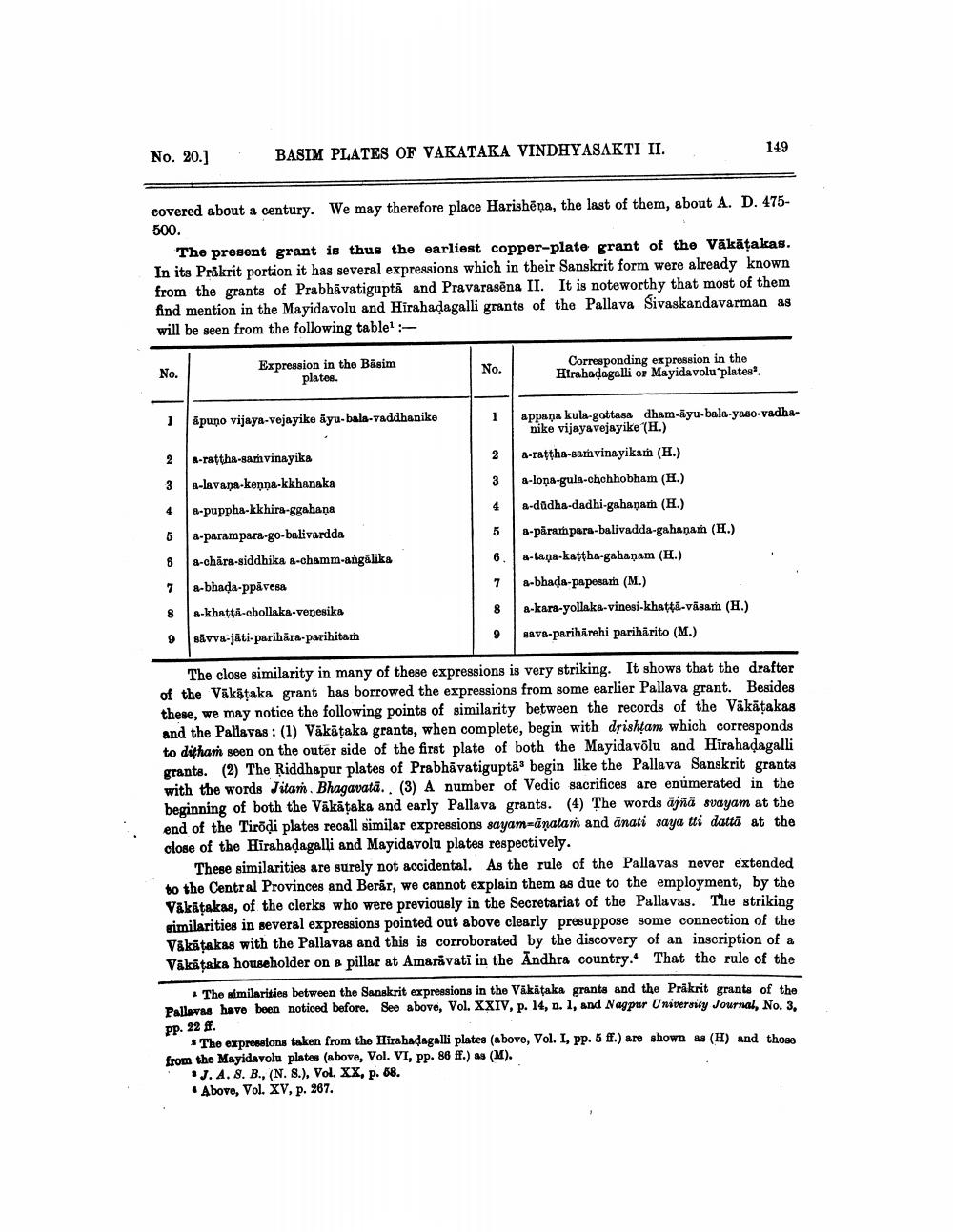________________
No. 20.]
BASIM PLATES OF VAKATAKA VINDHYASAKTI II.
149
covered about a century. We may therefore place Harishēņa, the last of them, about A. D. 475500.
The present grant is thus the earliest copper-plate grant of the Vākātakas. In its Präkrit portion it has several expressions which in their Sanskrit form were already known from the grants of Prabhāvatiguptă and Pravarasēna II. It is noteworthy that most of them find mention in the Mayidavolu and Hirahadagalli grants of the Pallava Sivaskandavarman as will be seen from the following table! :
NO.
Expression in the Basim
plates.
Corresponding expression in the Hirabadagalli or Mayidavolu plates
ápuno vijaya-vejayike ayu-bala-vaddhanike
R-rattha-samvinayika a-lavaņa-kenna-kkhanaka a-puppha-kkhira-ggahana a-parampara-go-balivardda a-chära-siddhika a-chamm-angalika a-bhada-ppress A-khattā-cbollaka-venesika savva-jäti-parihara-parihitam
appana kula-gottasa dham-äyu-bala-ymo-vadha
nike vijayavejayike (H.) a-raţtha-samvinayikam (H.) a-lona-gula-chchhobham (H.) a-dūdha-dadhi-gahanam (H.) a-pārampara-balivadda-gahanam (H.) a-tana-kattha-gahanam (H.) a-bhada-papesar (M.) a-kara-yollaka-vinesi-khatti-visam (H.) sava-parihirehi pariharito (M.)
8
The close similarity in many of these expressions is very striking. It shows that the drafter of the Vakitaka grant has borrowed the expressions from some earlier Pallava grant. Besides these, we may notice the following points of similarity between the records of the Vākāțakas and the Pallavas : (1) Vākāțaka grants, when complete, begin with drishtam which corresponds to ditham seen on the outer side of the first plate of both the Mayidavölu and Hirahadagalli granta. (2) The Riddhapur plates of Prabhāvatiguptābegin like the Pallava Sanskrit grants with the words Jitan Bhagavată.. (3) A number of Vedic sacrifices are enumerated in the beginning of both the Väkāțaka and early Pallava grants. (4) The words ājña svayam at the end of the Tirödi plates recall similar expressions sayam-anatam and anati saya ti dattā at the close of the Hirahadagalli and Mayidavolu plates respectively.
These similarities are surely not accidental. As the rule of the Pallavas never extended to the Central Provinces and Berar, we cannot explain them as due to the employment, by the Vākāțakas, of the clerks who were previously in the Secretariat of the Pallavas. The striking similarities in several expressions pointed out above clearly presuppose some connection of the V&katakas with the Pallavas and this is corroborated by the discovery of an inscription of a Väkätska householder on a pillar at Amaravati in the Andhra country. That the rule of the
The similarities between the Sanskrit expressions in the Vakataka grants and the Prakrit grants of the Pallovas have been notioed before. See above, Vol. XXIV, p. 14, n. 1, and Nagpur University Journal, No. 3, Pp. 22 ff.
The expressions taken from the Hirabadagalli plates (above, Vol. I, pp. 6 ff.) are shown as (H) and thom from the Mayidavola plates (above, Vol. VI, pp. 86 ff.) as (M).
J.A. 8. B., (N. 8.), Vol. XX, p. 68. . Above, Vol. XV, p. 267.




